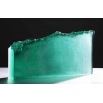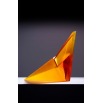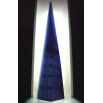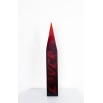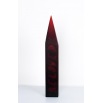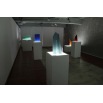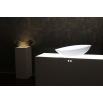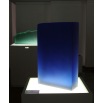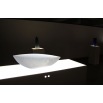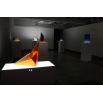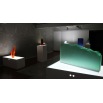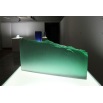*************************************************************************************************
Other events in March 2015:
SICD - 3rd South Island Art Night
HK Art Gallery Association - ART GALLERY NIGHT
*************************************************************************************************
Exhibition Date: 17 February, 2015 - 18 April, 2015
Emma Camden and David Murray have quietly yet confidently been pushing the envelope of cast glass. Living away from the major cities in a remote town called Whanganui on the west coast of New Zealand has allowed both artists to flourish.
Being such a demanding medium glass can quite often be bound by its technical attributes rather than its artistic intent. Process often becomes a significant part of the finished product to a degree where the concept or an ability to convey an idea is eclipsed by technical trickery. Emma Camden and David Murray successfully span the bridge between practical expertise and artistic concept which pulls their work in a direction which is far beyond the vessels and bowls that have previously been associated with glass.
LEAPS OF FAITH
Murray pushes the medium of cast glass to its boundaries, to a point of nothingness or obliteration. Murray has become known for his signature ‘tool’ like pieces; bearing names like ‘Hunter’, ‘Gatherer’, ‘Cradle’ and ‘Territory’ they all evoke a sense of presence or action.
The pieces signal a quiet argument between Murray and glass. Although still labour intensive, these deceptively simple pieces are not as active in their symbolism. Murray doesn’t provoke the medium into action through recognisable form and therefore leaves us contemplating the question of what if? This shift in concept has required a leap of faith on Murray’s behalf where the idea is far more elusive than ‘hunting’ or ‘gathering’. Murray wants to capture moments of chance and change in this work, the inevitability of fate, rather than the product of fate. The moment in between knowing and not knowing where a leap of faith is required to see you through to the other side whether that be change, life or death.
This is not to say that Murray has all but abandoned a straight forward narrative as in works titled 'Territory' that sport a jagged edge and literally reference landscape. It still lingers at the edge of one new work and disappears in another, as Murray says it takes a certain amount of courage to let go of clues to access. The beginning of this suite of work can be traced to a work that bore the word ‘Liberty’ in tablet format with a turned-up edge. As much about human liberty and freedom, it could be said that by abandoning recognisable form or incorporating text in his work Murray has allowed himself a certain liberty to let concept push ahead of form. Glass has a tendency to be read too quickly or be read as ‘craft’ – but as Murray forges on he encourages people to linger and for the viewer to work harder to receive meaning.
PASSAGES
Architecture has been a continual strand in Emma Camden’s work since her time at art school. Her dissertation was on the metaphysical paintings of Georgio de Chirico the style of which has been a constant reference point – perspective askew pushing the viewer to see her work at an unsettling angle. Other historical touchstones include the paintings in the ruins of Pompeii, images of gatehouses or towers on the walls of bedrooms that were believed to be access points to the spirit world whilst people were sleeping.
Camden’s previous works featured tipping viaducts, gatehouses and towers and explore a ‘sense of place’, family ties and genealogy. Recent large life leaps – motherhood, loss of a parent and a new sense of place have pushed Camden into new territory. Rather than architectural motifs being points of reference to another place Camden has utilised the pyramid form to engage in a poignant conversation with grief and the memory of her mother. Claustrophobic and open at the same time, these weighty pieces are fractured by shafts of light, access to the outer is through a very small passage in a very heavy dense structure. Camden is exploring the in-between places, the access points to the past, present and future and the unknown.
The sheer size of some of Camden’s pieces has sometimes created a necessary break, to cast on the scale that some pieces comprise is technically difficult therefore components sometimes make the whole. The passage works are sliced down the middle placed slightly apart almost as though to give breathing space between the long shafts that slice through.
Background of the artists:
Emma Camden
Working exclusively with cast glass, Emma Camden has constantly pushed the boundaries of the medium and broken new ground in the area of large scale casting. Her work is conceptually driven, often exploring issues arising from her identity and personal experience. Her current series investigates large scale solid forms and ideas of structure and architecture.
Camden has received considerable recognition for both her technical and sculptural innovation. She has received numerous awards, including being one of the few New Zealand artists to have won the supreme award for the Ranamok Glass Prize (Australia). One of her signature tower works was also featured in a limited edition applied arts series of New Zealand postage stamps in 2002.
Camden currently works full time as an artist in Whanganui, New Zealand. Her work is held in major collections locally and Internationally including the Auckland Museum, Auckland, the National Art Glass Collection, Wagga Wagga, Australia, and Ebeltost Museum, Denmark.
David Murray
Currently a full-time glass artist, David Murray came to the medium from a background in slip-cast ceramics. He studied at the School of Art, Otago Polytechnic, in the late 1980's and has recently attended workshops by many of the leading New Zealand and international glass artists. Murray's work is highly sought after for both exhibition and collection and is held in public collections internationally. In 2003 he was awarded the premier award in the Ranamok Prize for contemporary glass.
Murray achieved a high level of technical skill and critical acclaim after only a few years of working as a full-time glass artist. His signature series, the Hunter/Gatherer, struck a chord with local and international audiences for both their intention and strong, highly resolved form.


